The Detroit, Toledo and Ironton Railroad operated from 1905 to 1983 between its namesake cities of Detroit, Michigan, and Ironton, Ohio, via Toledo. At the end of 1970, it operated 478 miles of road on 762 miles of track; that year it carried 1,244 million ton-miles of revenue freight.
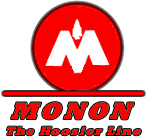
The Monon Railroad, also known as the Chicago, Indianapolis, and Louisville Railway from 1897 to 1971, was an American railroad that operated almost entirely within the state of Indiana. The Monon was merged into the Louisville and Nashville Railroad in 1971, and much of the former Monon right of way is owned today by CSX Transportation. In 1970, it operated 540 miles (870 km) of road on 792 miles (1,275 km) of track; that year it reported 1320 million ton-miles of revenue freight and zero passenger-miles.

The Pittsburgh, Cincinnati, Chicago and St. Louis Railroad, commonly called the Pan Handle Route, was a railroad that was part of the Pennsylvania Railroad system. Its common name came from its main line, which began at Pittsburgh, Pennsylvania, crossed the Northern Panhandle of West Virginia, and continued west to Bradford, Ohio, where it split into a northern line to Chicago and a southern one through Indianapolis, Indiana, to East St. Louis, Illinois.
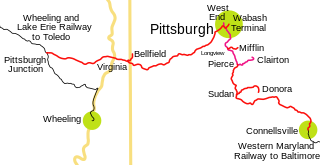
The Pittsburgh and West Virginia Railway was a railroad in the Pittsburgh, Pennsylvania and Wheeling, West Virginia, areas. Originally built as the Wabash Pittsburgh Terminal Railway, a Pittsburgh extension of George J. Gould's Wabash Railroad, the venture entered receivership in 1908 and the line was cut loose. An extension completed in 1931 connected it to the Western Maryland Railway at Connellsville, Pennsylvania, forming part of the Alphabet Route, a coalition of independent lines between the Northeastern United States and the Midwest. It was leased by the Norfolk and Western Railway in 1964 in conjunction with the N&W acquiring several other sections of the former Alphabet Route, but was leased to the new spinoff Wheeling and Lake Erie Railway in 1990, just months before the N&W was merged into the Norfolk Southern Railway.
The Indiana Rail Road is a United States Class II railroad, originally operating over former Illinois Central Railroad trackage from Newton, Illinois, to Indianapolis, Indiana, a distance of 155 miles (249 km). This line, now known as the Indiana Rail Road's Indianapolis Subdivision, comprises most of the former IC/ICG line from Indianapolis to Effingham, Illinois; Illinois Central successor Canadian National Railway retains the portion from Newton to Effingham. INRD also owns a former Milwaukee Road line from Terre Haute, Indiana, to Burns City, Indiana, with trackage rights extending to Chicago, Illinois. INRD no longer serves Louisville, Kentucky, and the Port of Indiana on the Ohio River at Jeffersonville, Indiana, through a haulage agreement with the Louisville & Indiana Railroad (LIRC).
The Indiana Railroad (IR) was the last of the typical Midwestern United States interurban lines. It was formed in 1930–31 by combining the operations of the five major interurban systems in central Indiana into one entity. The predecessor companies came under the control of Midland Utilities, owned by Samuel Insull. His plan was to modernize the profitable routes and abandon the unprofitable ones. With the onset of the Great Depression, the Insull empire collapsed and the Indiana Railroad was left with a decaying infrastructure and little hope of overcoming the growing competition of the automobile for passenger business and the truck for freight business. The IR faced bankruptcy in 1933, and Bowman Elder was designated as the receiver to run the company. Payments on bonded debt were suspended. Elder was able to keep the system virtually intact for four years, and IR operated about 600 miles (970 km) of interurban lines throughout Indiana during this period. During the late 1930s, the routes were abandoned one by one until a 1941 wreck with fatalities south of Indianapolis put an abrupt end to the Indiana Railroad's last passenger operations.
The Gateway Eastern Railway is a railroad subsidiary of the Kansas City Southern Railway (KCS), owning a 17-mile (27 km) main line between East Alton and East St. Louis, Illinois, United States. Originally created in 1994 as a subsidiary of the Gateway Western Railway, which acquired the East St. Louis-Kansas City line of the Chicago, Missouri and Western Railway in 1990, it was acquired by KCS along with its parent in 1997.

Springfield Union Station in Springfield, Illinois, is a former train station and now part of the complex of buildings that together form the Abraham Lincoln Presidential Library and Museum. It is listed on the National Register of Historic Places, and is located at 500 East Madison Street in downtown Springfield, adjacent to the Lincoln Presidential Library.
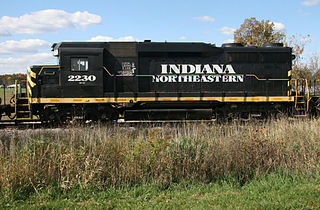
The Indiana Northeastern Railroad is a Class III short line freight railroad operating on nearly 130 miles (210 km) in southern lower Michigan, northeast Indiana and northwest Ohio. The Indiana Northeastern Railroad Company began operations in December 1992 and is an independent privately owned company. As of 2017 the railroad hauled more than 7,000 carloads per year. Commodities moved by the railroad include corn, soybeans, wheat and flour. It also handles plastics, fiberboard, aluminum, copper, coal, perlite, stone, lumber, glass, rendering products, as well as agricultural fertilizers and chemicals.
The Prairie Central Railway was a short railroad line that ran from Decatur to Paris, Illinois. It was based in Decatur, and ran on about 74 miles (119 km) worth of mostly former Pennsylvania, later Penn Central Railroad, Conrail and eventually Wabash Valley Railroad trackage. In 1982, the railroad was extended to include approximately 80 miles (130 km), south from Paris to Mt. Carmel on former New York Central trackage, terminating at the Southern Railway.
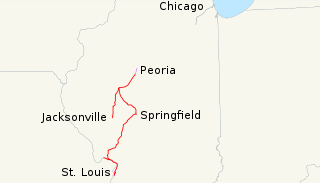
The Chicago, Peoria and St. Louis Railroad (CP&StL) was a railroad in the U.S. state of Illinois that operated a main line between Pekin and Madison via Springfield. Its property was sold at foreclosure to several new companies in the 1920s; the portion north of Springfield has since become the Illinois and Midland Railroad, while the remainder has been abandoned, except for a portion near St. Louis that is now owned by the Norfolk Southern Railway.
The Cincinnati Northern Railroad was a railroad that stretched from Franklin, Ohio north to Jackson, Michigan, a distance of about 186 miles (299 km). It was acquired by the Cleveland, Cincinnati, Chicago and St. Louis Railway in 1901 and the New York Central Railroad several years later. Most of the line has since been abandoned.
The 3 ft narrow gauge Danville, Olney and Ohio River Railroad ran south from Sidell to West Liberty, Illinois and existed in the late 19th century.
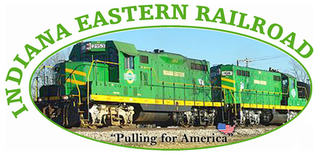
The Indiana Eastern Railroad is a short-line railroad in the U.S. states of Indiana and Ohio, operating a former Chesapeake and Ohio Railway line between Richmond, Indiana and Fernald, Ohio under lease from CSX Transportation. It began operations in 2005 as a subsidiary of the Respondek Railroad, and interchanges freight with CSX at Cottage Grove. Its business headquarters is in Edwardsville, Illinois with its operations headquarters in Liberty, Indiana

The Winamac Southern Railway is a short-line railroad in northern Indiana, United States, operated under lease by the Toledo, Peoria and Western Railway. It owns two lines radiating from Logansport to Kokomo and Bringhurst, and formerly a third to Winamac, all former Pennsylvania Railroad lines acquired from Conrail in 1993. It hauls mainly outbound grain and inbound agricultural supplies, connecting with the Toledo, Peoria and Western Railway at Logansport and with the Central Railroad of Indianapolis at Kokomo. Until 2009, the Central Railroad of Indianapolis operated the company as agent.

The Erie Western Railway was a Class III railroad operating in Illinois and Indiana from 1977 until 1979, operating a segment of the former Erie Lackawanna mainline that was not included in the Conrail Final System Plan.
The following is a brief history of the North American rail system, mainly through major changes to Class I railroads, the largest class by operating revenue.
The Litchfield and Madison Railway was a Class I railroad in Illinois in the United States. Its nickname was the St. Louis Gateway Route. The railroad operated 44 miles (71 km) of track from its creation in 1900 until it was absorbed by the Chicago and North Western Railway in 1958.

The Wabash Railroad was a Class I railroad that operated in the mid-central United States. It served a large area, including track in the states of Ohio, Indiana, Illinois, Iowa, Michigan, and Missouri and the province of Ontario. Its primary connections included Chicago, Illinois; Kansas City, Missouri; Detroit, Michigan; Buffalo, New York; St. Louis, Missouri; and Toledo, Ohio.

The Vandalia Railroad Company was incorporated January 1, 1905, by a merger of several lines in Indiana and Illinois that formed a 471-mile railroad consisting of lines mostly west of Indianapolis.












